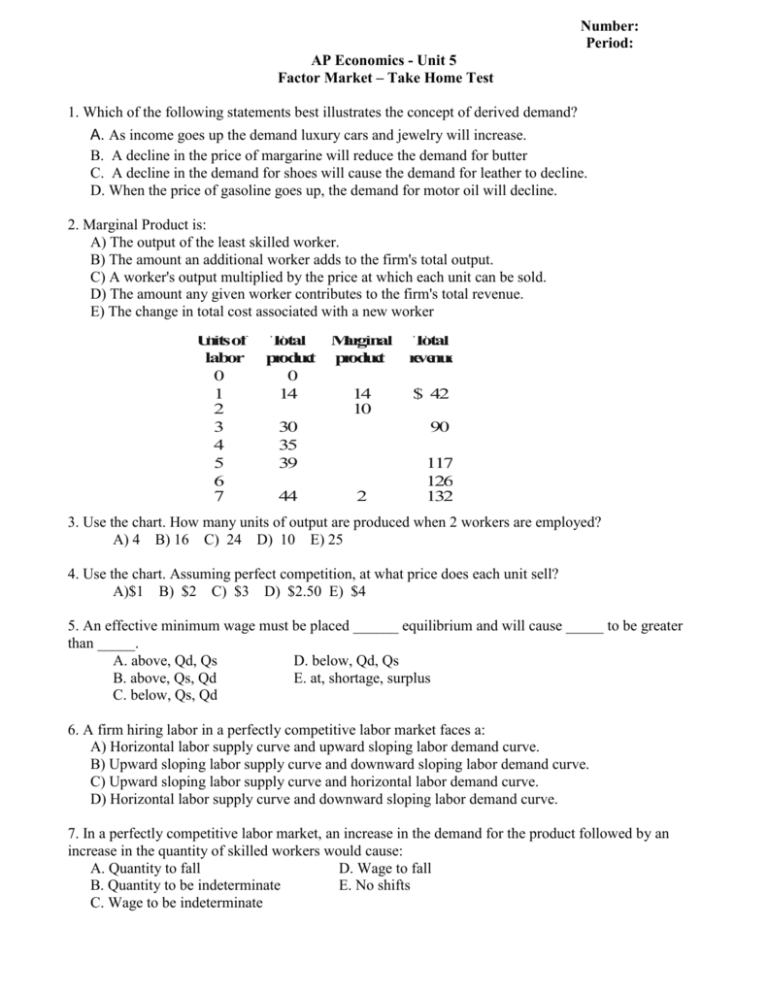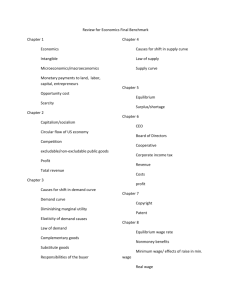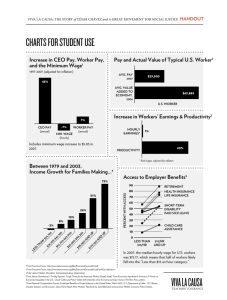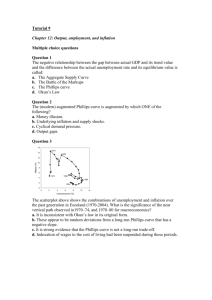Unit 5: Factor Market
advertisement

Number: Period: AP Economics - Unit 5 Factor Market – Take Home Test 1. Which of the following statements best illustrates the concept of derived demand? A. As income goes up the demand luxury cars and jewelry will increase. B. A decline in the price of margarine will reduce the demand for butter C. A decline in the demand for shoes will cause the demand for leather to decline. D. When the price of gasoline goes up, the demand for motor oil will decline. 2. Marginal Product is: A) The output of the least skilled worker. B) The amount an additional worker adds to the firm's total output. C) A worker's output multiplied by the price at which each unit can be sold. D) The amount any given worker contributes to the firm's total revenue. E) The change in total cost associated with a new worker Unitsof labor 0 1 2 3 4 5 6 7 Total Marginal product product 0 14 14 10 30 35 39 44 2 Total revenue $ 42 90 117 126 132 3. Use the chart. How many units of output are produced when 2 workers are employed? A) 4 B) 16 C) 24 D) 10 E) 25 4. Use the chart. Assuming perfect competition, at what price does each unit sell? A)$1 B) $2 C) $3 D) $2.50 E) $4 5. An effective minimum wage must be placed ______ equilibrium and will cause _____ to be greater than _____. A. above, Qd, Qs D. below, Qd, Qs B. above, Qs, Qd E. at, shortage, surplus C. below, Qs, Qd 6. A firm hiring labor in a perfectly competitive labor market faces a: A) Horizontal labor supply curve and upward sloping labor demand curve. B) Upward sloping labor supply curve and downward sloping labor demand curve. C) Upward sloping labor supply curve and horizontal labor demand curve. D) Horizontal labor supply curve and downward sloping labor demand curve. 7. In a perfectly competitive labor market, an increase in the demand for the product followed by an increase in the quantity of skilled workers would cause: A. Quantity to fall D. Wage to fall B. Quantity to be indeterminate E. No shifts C. Wage to be indeterminate M a r g in a l P r o d u c t W a g e E m p lo y m e n t p r o d u c t p r ic e E m p lo y m e n t r a te 0 0 $ 3 0 $ 1 1 1 1 4 3 1 1 1 2 1 2 3 2 1 1 3 9 3 3 1 1 4 7 3 4 1 1 5 4 3 5 1 1 6 2 3 6 1 1 8. Use the chart. At a wage of $20, the firm will maximize profits by employing how many workers? A) 2 B) 3 C) 4 D) 5 E) 6 9. The firm illustrated by the chart above has a MRP curve that is: A) downsloping B) upsloping. C) perfectly inelastic. D) perfectly elastic. E) unknowable 10. Use the graph. The firm's total labor cost: A)is 0abc. B) is 0wbc. C) is wab. D) is cbd 11.Use the graph. The above firm: A) Hires labor in an imperfectly competitive labor market. B) Is selling its product in an imperfectly competitive market. C) Is a wage taker. D) Must pay a higher marginal resource cost for each successive worker. E) Is a wage maker. 12. Use the graph. If the government requires workers to obtain a license in this industry, what will happen to the wage and quantity of workers hired by the firm? A. The wage will stay the same, but the MRP would increase so quantity would increase B. The wage would fall and the quantity would decrease C. The wage would fall and the quantity would increase D. The wage would increase and quantity would increase E. The wage would increase and the quantity would fall 13. Which of the following is NOT a characteristic of a monopsony? A. There is one firm hiring workers B. The firm must increase the wage to increase the quantity of labor supplied C. The MRC for the firm is upsloping, but the MRP for the market is perfectly elastic D. Workers are immobile E. The firm is a wage maker








